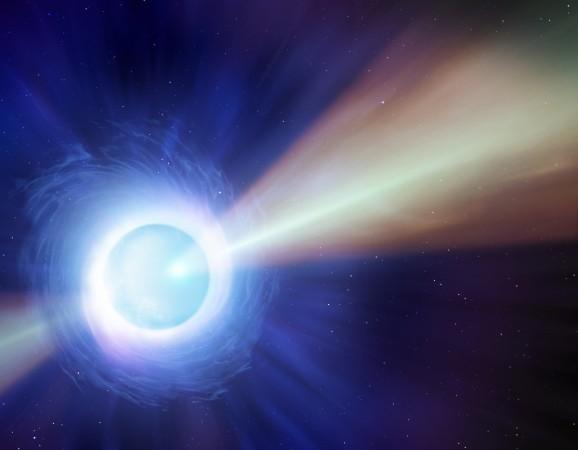
Neutron stars are the densest objects in the universe and even they fall at the same rate as a light feather would, researchers have found. The study shows Einstein's theories on general relativity is true yet again.
The theory proposed by Albert Einstein in 1916 spoke of gravity as a consequence of space-time's inherent flexibility. The fabric of space-time holds all cosmic bodies, which in turn distort the fabric and create pockets or wells around which other bodies revolve. The Sun is inside one such well, the Earth has its own smaller one. Massively dense neutron stars have their own wells.
One of the most important points that the theory makes is called the "Equivalence Principle", notes a report by the National Radio Astronomy Observatory (NRAO). It explains the nature of gravity and that all objects fall at the same rate. It is a principle that has been tested over and over on Earth, even Galileo is believed to have tested this by dropping things of different densities from the Leaning Tower of Pisa. Heavier objects do not fall faster than lighter objects.
A hammer and feather were dropped on the Moon by David Scott during the Apollo 15 mission and they both landed at exactly the same time on the lunar surface.
This principle has now been tested on neutron stars.
In 2011, the National Science Foundation's (NSF) Green Bank Telescope (GBT) found a way to test this theory in extreme conditions using an existing star system as a laboratory.
A triple star system named PSR J0337+1715, which is located about 4,200 light years from Earth was chosen for the study. The star system has is a neutron star locked in a rapid orbit that lasts only 1.6 days around a white dwarf star, the two bodies are, in turn, on a 327-day orbit around another white dwarf star much further away.
Ryan Lynch, a co-author on the paper of the Green Bank Observatory in West Virginia said that this is a unique star system, adding, "We don't know of any others quite like it. That makes it a one-of-a-kind laboratory for putting Einstein's theories to the test."
Over the years, the stars have been under regular observation by the GBT, the Westerbork Synthesis Radio Telescope in the Netherlands, as well as the NSF's Arecibo Observatory in Puerto Rico, notes the release. Over 400 hours have been spent observing this system, taking data and measuring how the objects move in relation to each other.
The fast-spinning neutron star is a pulsar, notes the report. Pulsars often times spin with a precise consistency that is equal to atomic clocks on here on Earth, says the report. "As one of the most sensitive radio telescopes in the world, the GBT is primed to pick up these faint pulses of radio waves to study extreme physics," Lynch said. This particular neutron star was found to "pulse" or rotate at a rate of 366 times every second.

"We can account for every single pulse of the neutron star since we began our observations," said Anne Archibald of the University of Amsterdam and the Netherlands Institute for Radio Astronomy and principal author on the paper. "We can tell its location to within a few hundred meters. That is a really precise track of where the neutron star has been and where it is going."
If Einstein's proposed theory on gravity was incorrect, the neutron star and the inner white dwarf should each fall at rates that are completely differently toward the outer white dwarf, around which both of them revolve. "The inner white dwarf is not as massive or compact as the neutron star, and thus has less gravitational binding energy," said Scott Ransom, co-author on the paper.
After a lot of observations and astronomers carefully calculating the results, the team was able to test the triple star system's gravity using pulses from only the neutron star. Researchers found that if there is any acceleration difference between the much heavier neutron star and its inner white dwarf pair, it is too small to detect.
"If there is a difference, it is no more than three parts in a million," said coauthor Nina Gusinskaia.
NRAO reports that this result is ten times more precise than the previous best test of gravity. This means, for now, Einstein's Strong Equivalence Principle stands. Alternative theories to General Relativity are not looking too good at this time.














